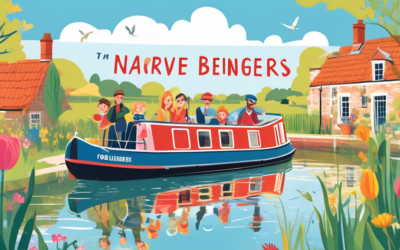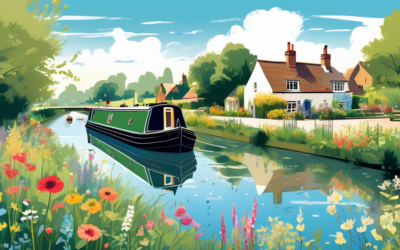Classic Canal Boat Restoration: A Beginner’s Guide
The gentle chugging of an engine through tranquil waters, the lush greenery of the English countryside blurring past, and the unique charm of a classic narrowboat beneath you – this idyllic scene captures the essence of canal boating. Across the scenic waterways of the North West of England, including the Four Counties, Cheshire Ring, and Llangollen Canal, classic canal boats are a delightful sight. If you’ve succumbed to their charm and are considering restoring one, you’re embarking on a rewarding journey. Whether your heart is set on restoring a historic narrowboat or a broadbeam for leisurely cruising these heritage-rich canals, this beginner’s guide will help you navigate the waves of classic canal boat restoration.
Understanding the Basics of Canal Boat Restoration
Before diving into the nitty-gritty of restoration, it’s essential to grasp what it entails. Restoration goes beyond mere repair. It’s about bringing a boat back to its original glory, considering both aesthetics and functionality. It involves structural repairs, engine refurbishment, interior remodeling, and sometimes, even a complete overhaul. The goal is to preserve the boat’s heritage while making it viable for modern use.
Getting Started with Your Classic Canal Boat Restoration
Firstly, understanding what you’re getting into is crucial. Each canal boat has its own history and peculiarities. Maybe it has meandered along the serene Llangollen Canal, or carried goods through the bustling Cheshire Ring. Here’s how to get started:
- Research: Learn about your boat’s history, design, and typical issues that boats of its age and type face. Local libraries, maritime museums, and canal boat enthusiasts, especially those native to the North West of England, are good places to start.
- Inspection: A thorough inspection by an experienced surveyor can save you from costly surprises down the line. Focus on the hull’s condition, the engine, electrics, and potential damp issues.
- Planning: Based on the inspection, plan your restoration. It might be tempting to start with cosmetic changes, but prioritize structural and functional repairs. Create a budget, but be prepared for it to evolve.
Key Areas to Focus On in Your Restoration
Restoration projects can be overwhelming, but focusing on key areas helps manage the process:
- Hull restoration: The hull is your boat’s foundation. Addressing leaks, rusting, and ensuring it’s properly coated is critical. On the waterways around the North West, the condition of your hull directly impacts your cruising experience.
- Engine and electrical systems: A reliable engine and electrical systems are essential for safety and comfort. Consider modern, more efficient replacements that respect the boat’s vintage.
- Interior refurbishment: While modernizing the interior, try to retain original features and use materials and designs that reflect the boat’s era. It’s not just about living comfort. It’s about honoring the boat’s heritage while making it functional for today’s needs.
Learning from Local Experts
Engaging with the canal boat community can significantly impact your restoration journey. In the North West, seasoned boaters often possess invaluable knowledge on restoration techniques and local suppliers. Forums, social media groups, and local boat clubs, such as those focused on the Cheshire Ring or Llangollen Canal, can offer advice, support, and sometimes, a helping hand.
The Restoration Process: A Labor of Love
Restoration is not just about the physical work; it’s about connecting with the boat’s past and envisioning its future. Here are some steps and tips to guide you:
- Take it step by step: Address one area at a time. Trying to tackle everything at once can be overwhelming and could lead to issues being overlooked.
- Document your journey: Keeping a detailed record of your restoration process can be incredibly rewarding. It’s also practical, as it helps track expenses and the work done for future reference or resale.
- Be patient: Restoration projects often take longer and cost more than initially expected. Embrace the process, and remember why you started.
One heartwarming story comes from a local who restored a 70-year-old narrowboat that had once ferried goods along the Llangollen Canal. The restoration, filled with challenges, took nearly two years. But the sense of achievement and the connection to the boat’s storied past made every moment worth it. The once-forgotten vessel is now a beautifully restored piece of history, cruising the waters once again.
Conclusion
Classic canal boat restoration is a journey that’s as meandering and filled with discoveries as the waterways of the North West. It’s a commitment to preserving a piece of history, to learning new skills, and, most importantly, to bringing a cherished vessel back to life. The camaraderie in the boating community, the satisfaction of tackling each challenge, and the sheer joy of cruising on a boat you’ve restored are unparalleled. Whether it’s the vibrant waters of the Four Counties, the historic loops of the Cheshire Ring, or the tranquil stretches of the Llangollen Canal, your restored classic canal boat is your ticket to an exceptional adventure. Embark on this journey with patience, passion, and a keen eye for detail, and you’ll find the experience to be incredibly rewarding.
As you launch your lovingly restored boat onto the canals, reflecting on the journey, remember: you’re not just a restorer of boats; you’re a keeper of history. Through your efforts, these classic vessels continue to grace our waterways, captivating everyone they pass by. So, here’s to the bold adventurers embarking on the timeless art of classic canal boat restoration. May your journeys be smooth, your stories rich, and your waters ever calm.
Fancy a boat holiday – Check out Floating Holidays fleet for hire!






0 Comments